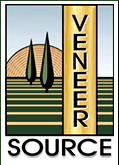







Characteristics
One of the qualities which contributes to the widespread use of wood is the option offered for æsthetic selection. It varies between species, between two logs of the same species, and between two boards from the same log. Æsthetic considerationsin specifying wood are influenced by the following characteristics:
A. Color - The basic hue of the species, which may be further enhanced by the finishing process employed.
Sapwood and heartwood - The color of wood within a tree varies between the “sapwood" (the outer layers of the tree that continue to transport sap), which is usually lighter in color than the “heartwood" (the inner layers in which the cells have become filled with natural deposits). If desired, sapwood may be stained in the finishing process to blend with the heartwood.
This difference in color is so pronounced in certain species that the sapwood is marketed under a different nomenclature from the heartwood. Some examples are:
Select White Birch - sapwood of Yellow or Paper Birch
Select Red Birch - heartwood of Yellow Birch
Natural Birch - both sapwood and heartwood of any Birch
Select White Ash - sapwood of White or Green Ash
Select Brown Ash - heartwood of Black Ash
Natural Ash - both sapwood and heartwood of any Ash
Select White Maple - sapwood of the Sugar Maple
B. Grain - The appearance produced by the arrangement of wood fibers and pores of the species. Open grain woods are said to be ring-porous and usually show a distinct grain pattern. Close grain woods are said to be diffuse-porous with even grain.
Note: Open Grain and Close
Grain
The size and distribution of the cellular structure of the wood influences the appearance and uniformity.
Open grain hardwoods, such as Elm, Oak, Ash, and Chestnut are ring-porous species. These
species have distinct figure and grain patterns. Close grain hardwoods, such as Cherry, Maple,
Birch, and Yellow Poplar, are diffuse-porous species. Most North American diffuse-porous woods
have small, dense pores resulting in less distinct figure and grain. Some tropical diffuse-porous species (e.g.,
Mahogany) have rather large pores.
C. Figure - Various species produce different grain patterns (figures), which influence the selection process. There will be
variations of grain patterns within any selected species. The architectural woodworker cannot select solid lumber cuttings
within a species by grain and color in the same manner in which veneers may be selected.
D. Methods of Sawing - The sawing method, and the selection of boards after sawing the log will produce the following types of lumber:
Plain Sawn
Plain sawing, the most common type of lumber sawing, yields broad grain, the widest boards and least waste. The annular rings are typically 30 degrees or less to the face of the board.
Quarter Sawn
Most often cut as Rift-and-Quartered, and then sorted for appearance, quarter sawn lumber is available in certain species, yields a straight grain, narrow boards, and fleck (sometimes called flake) or figure which runs across the grain in some species (notably the oaks). Dimensional stability across the grain is the best. The annular rings run approximately 60 to 90 degrees to the face of the board, with the optimum being 90 degrees. Quartered lumber is generally more expensive than plain sawn.
Rift Sawn
Rift sawing produces small flecks caused by cutting through the wood rays. Only certain species produce these flecks, primarily Red and White Oak. Rift cutting reduces yield and increases cost. The annular rings run about 30 to 60 degrees to the face of the board, with the optimum being 45 degrees.
E. Finishing Characteristics - The many species of wood vary considerably in their receptivity to the multitude of finishing processes on the market. Some woods, because of their open pores, will accept fillers while tighter grained woods will not. Some will show greater contrast between the “early wood" and the “late wood" when stained than others. Design professionals should take into consideration the finish that will be applied when selecting a particular species. Consult with an AWI/AWMAC woodworker about finishing prior to selection or specification. Providing large samples of the desired finish to woodworkers during the design phase and bidding process will assure the designer of obtaining an acceptable final product, while enabling the woodworker to be aware of exactly what is required.
... that managed forests, thanks to their high proportion of young, strong, growing trees, enable CO2 to be extracted?
... that an old, unmanaged forest produces as much CO2 through processes of decomposition and decay as it stores, and that therefore an unmanaged forest contributes nothing to reducing global CO2?


Phone: 407-423-2252 • Fax: 407-423-1566 • sales@veneersource.com